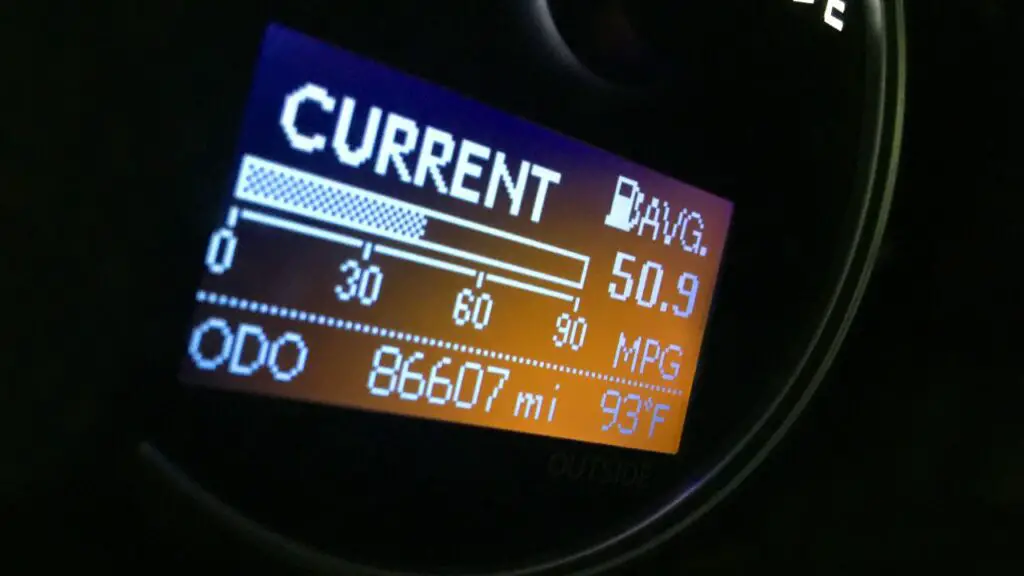Bad Gas Mileage on Your Honda CR-V? (Here’s Why)
The Honda CR-V is renowned for its impressive fuel economy. So, if you notice your CR-V guzzling more gas than usual, something’s up. If you’ve been tracking your MPG, you might wonder why your trusty CR-V suddenly shows bad gas mileage.
A dip in fuel efficiency could point to a problem with the vehicle, but it might also be linked to driving habits. In this article, I will cover the various reasons you might be experiencing poor gas mileage in your Honda CR-V and provide tips to help you maximize your driving distance per tank.

What to Expect
The 2024 or 2025 CR-V is one of the Honda’s most efficient vehicles.
Here’s a brief overview of the mileage of the 2024 Honda CR-V is rated for.
- 2024 Honda CR-V FWD: 28/34* MPG
- 2024 Honda CR-V AWD 27/32* MPG
- 2024 Honda CR-V Hybrid FWD 43/36* MPG
- 2024 Honda CR-V Hybrid AWD 40/34* MPG
*(city/highway)
Honda CR-V models up to 2019 have maintained similar fuel economy ratings, though there was a slight drop in efficiency with the previous generation. To find out what your CR-V should typically achieve, check out our comprehensive Honda CR-V MPG list.
Knowing what to expect from your CR-V’s fuel economy makes it much easier to identify when something goes wrong.
Real-World Factors
Fuel economy ratings for today’s cars are released by the US Department of Energy, but these ratings don’t always match real-world driving conditions.
Many factors influence a vehicle’s fuel consumption, so data from a single source shouldn’t be taken as the absolute benchmark. Various real-world scenarios can cause your actual MPG to be higher or lower than government ratings.
For example, my CR-V has a city rating of 28 MPG, but I usually average around 24 MPG. This difference is due to my frequent short trips with many traffic lights and occasional weekend trailer towing.
Here are some factors that affect fuel consumption in real-world driving:
- Frequent stop-and-go driving
- Aggressive acceleration and braking
- Excessive idling
- Driving at high speeds and aerodynamic drag
- Cold weather and frequent short trips
- Heavy cargo load
- Cargo rack on the roof
- Towing
- Air conditioner usage
- Hilly Terrain
- Off-road
- Using four-wheel drive
If you drive in any of the above situations, you can expect a drop in fuel economy.
Vehicle Problems That Impact Fuel Economy
If you feel no change in your driving habits but experience a sudden drop in MPG, it may be due to a mechanical issue, such as:
- Fuel injectors issue (clogged, dirty, damaged)
- Bad fuel pump
- Bad air filter
- Bad fuel filter
- Malfunctioning oxygen sensors
- Worn-out piston rings
- Bad Ignitions system parts (spark plugs, coils, etc)
- Incorrect engine oil (too thick)
- Low tire pressure
- Stuck break
- Poor wheel alignment
(firestonecompleteautocare.com)
Many of these problems can be prevented by following the recommended CR-V maintenance schedule. However, mechanical failures can still occur, even with diligent care.
To find out what mechanical issue is causing your CR-V’s poor fuel economy, you’ll need to have it inspected. If you’re not mechanically inclined, take your car to a trusted dealership or technician for a thorough checkup.
How to Get Better Mpg

There are many ways to improve the gas mileage on your Honda CR-V, some of which are practical and easy to implement. Here are a few suggestions to consider.
- Use Econ mode
- Remove unnecessary cargo
- remove the roof box when not in use
- Slow down, avoid aggressive acceleration and braking
- Ensure Your Tires Are Properly Inflated
- Avoid Idling For Too Long
- use the right engine oil
- Be wise in using AC
- Keep up with regularly scheduled maintenance
Good driving habits and regular vehicle care ensure better fuel economy and keep your CR-V in optimal condition.
Frequently Asked Questions
Yes, the 2024 Honda CR-V Hybrid is rated at 43/36 city/highway MPG. Other Honda CR-V models from 2023 to 2025 are also fuel-efficient. Even older models of the CR-V have better fuel consumption compared to many competitors in the same segment.
A mechanical failure is the most likely cause of a sudden drop in gas mileage. You should take your CR-V to a trusted mechanic to diagnose and resolve the issue.
Yes, Econ mode is designed primarily to improve fuel economy. The trade-off is a slight decrease in vehicle performance. Compared to normal mode, the vehicle may be a bit less responsive when using the Econ mode setting.
Unlock the Full Potential of Your CR-V
Fuel economy figures were one of the reasons I chose the Honda CR-V, and you probably did, too. It’s important to maximize its efficiency to save money. That’s why any drop in fuel economy should be addressed immediately.
If the drop in fuel economy is due to your driving habits, make changes immediately to improve efficiency. Otherwise, have a mechanic inspect your CR-V to determine the issue. Ultimately, maintaining a fuel-efficient vehicle offers numerous benefits.

Are all the required maintenance schedules in the owner’s manual? (such as changing brake fluid every 30,000 miles.) Thank You!
Yes, but it lacks the level of detail we’d prefer. You can find the user guide in the Maintenance Minder section, which lists the required maintenance items. However, it does not specify when or at what mileage each service should be performed. Instead, you must rely on the Maintenance Minder system to notify you when maintenance is due.
If you’re looking for a more detailed schedule, I’ve written an article outlining the recommended maintenance intervals based on mileage. You can read it here: Honda CR-V Maintenance Schedule